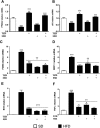Impact of pioglitazone and bradykinin type 1 receptor antagonist on type 2 diabetes in high-fat diet-fed C57BL/6J mice
- PMID: 29071111
- PMCID: PMC5598024
- DOI: 10.1002/osp4.117
Impact of pioglitazone and bradykinin type 1 receptor antagonist on type 2 diabetes in high-fat diet-fed C57BL/6J mice
Abstract
Aim: Type 2 diabetes (T2D) is a major complication of obesity and a leading cause of morbidity and mortality. Antagonizing bradykinin type 1 receptor (B1R) improved body and tissue fat mass and reversed vascular and adipose tissue inflammation in a rat model of insulin resistance. This study aimed at evaluating further the role of B1R in a mouse model of T2D by comparing the antidiabetic and anti-inflammatory effects of the B1R antagonist SSR240612 (SSR) in adipose tissue with those of pioglitazone (TZD), an activator of peroxisome proliferator-activated receptor gamma.
Methods: C57BL/6J mice were fed with high-fat diet (HFD) or standard diet (control) for 20 weeks. Yet, during the last 4 weeks, HFD-fed mice were administered SSR and TZD (10 mg kg-1 d-1 each) as monotherapy or combined therapy subcutaneously. The impact of treatments was measured on metabolic hormones levels (ELISA), adipose tissue inflammatory status and the expression of candidate genes involved in T2D (quantitative real-time polymerase chain reaction and western blot).
Results: SSR240612 and TZD treatments improved hyperglycaemia, hyperinsulinaemia, insulin resistance, adipose tissue inflammation (expression of B1R, chemokine ligand 2, F4/80 and tumour necrosis factor) and modulated adipogenesis (peroxisome proliferator-activated receptor gamma, adipocytes' protein 2 and CD40 expressions) in HFD-fed mice. Yet, SSR was more effective than TZD to reduce visceral fat mass and resistin. TZD/SSR combined treatment had an additive effect to improve insulin sensitivity and glucose intolerance.
Conclusion: Bradykinin type 1 receptor antagonism could represent a promising therapeutic tool in combination with TZD for the treatment of T2D, obesity and insulin resistance.
Keywords: Adipose tissue inflammation; PPARγ; bradykinin B1 receptor; obesity.
Figures





Similar articles
-
Suppression of vascular inflammation by kinin B1 receptor antagonism in a rat model of insulin resistance.J Cardiovasc Pharmacol. 2012 Jul;60(1):61-9. doi: 10.1097/FJC.0b013e3182576277. J Cardiovasc Pharmacol. 2012. PMID: 22494994
-
Omega-3 fatty acids protect from diet-induced obesity, glucose intolerance, and adipose tissue inflammation through PPARγ-dependent and PPARγ-independent actions.Mol Nutr Food Res. 2015 May;59(5):957-67. doi: 10.1002/mnfr.201400914. Epub 2015 Mar 16. Mol Nutr Food Res. 2015. PMID: 25641959
-
TNP [N2-(m-Trifluorobenzyl), N6-(p-nitrobenzyl)purine] ameliorates diet induced obesity and insulin resistance via inhibition of the IP6K1 pathway.Mol Metab. 2016 Aug 21;5(10):903-917. doi: 10.1016/j.molmet.2016.08.008. eCollection 2016 Oct. Mol Metab. 2016. PMID: 27689003 Free PMC article.
-
Bovine α-Lactalbumin Hydrolysates (α-LAH) Ameliorate Adipose Insulin Resistance and Inflammation in High-Fat Diet-Fed C57BL/6J Mice.Nutrients. 2018 Feb 23;10(2):242. doi: 10.3390/nu10020242. Nutrients. 2018. PMID: 29473848 Free PMC article.
-
Fish oil prevents excessive accumulation of subcutaneous fat caused by an adverse effect of pioglitazone treatment and positively changes adipocytes in KK mice.Toxicol Rep. 2015 Nov 19;3:4-14. doi: 10.1016/j.toxrep.2015.11.003. eCollection 2016. Toxicol Rep. 2015. PMID: 28959521 Free PMC article.
Cited by
-
Whole patient knowledge modeling of COVID-19 symptomatology reveals common molecular mechanisms.Front Mol Med. 2023 Jan 4;2:1035290. doi: 10.3389/fmmed.2022.1035290. eCollection 2022. Front Mol Med. 2023. PMID: 39086962 Free PMC article.
-
The role of pioglitazone in antioxidant, anti-inflammatory, and insulin sensitivity in a high fat-carbohydrate diet-induced rat model of insulin resistance.Braz J Med Biol Res. 2021 May 24;54(8):e10782. doi: 10.1590/1414-431X2020e10782. eCollection 2021. Braz J Med Biol Res. 2021. PMID: 34037093 Free PMC article.
-
Beneficial Effects of Alpha-Lipoic Acid on Hypertension, Visceral Obesity, UCP-1 Expression and Oxidative Stress in Zucker Diabetic Fatty Rats.Antioxidants (Basel). 2019 Dec 16;8(12):648. doi: 10.3390/antiox8120648. Antioxidants (Basel). 2019. PMID: 31888243 Free PMC article.
References
-
- Unger RH, Clark GO, Scherer PE, Orci L. Lipid homeostasis, lipotoxicity and the metabolic syndrome. Biochim Biophys Acta 2010; 1801: 209–214. - PubMed
-
- Yadav A, Kataria MA, Saini V, Yadav A. Role of leptin and adiponectin in insulin resistance. Clin Chim Acta 2013; 417: 80–84. - PubMed
-
- Caselli C. Role of adiponectin system in insulin resistance. Mol Genet Metab 2014; 113: 155–160. - PubMed
LinkOut - more resources
Full Text Sources
Other Literature Sources
Molecular Biology Databases
Research Materials
